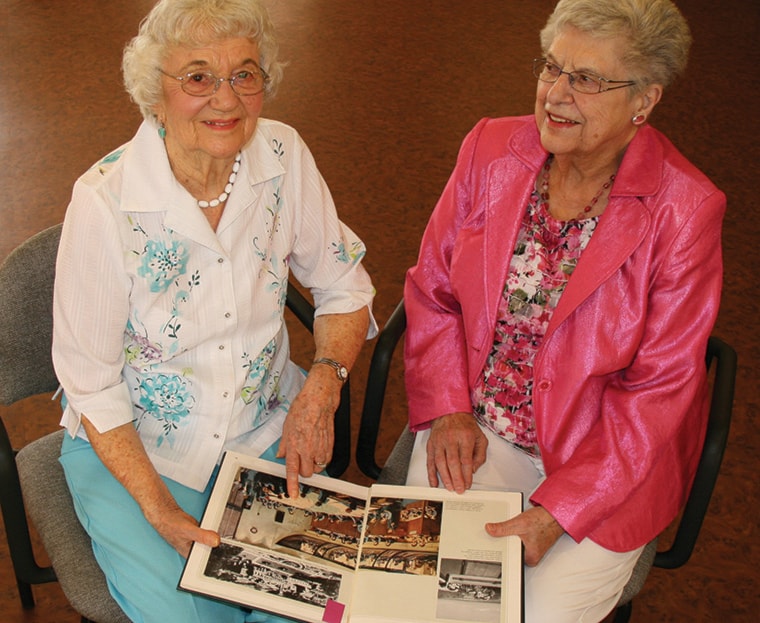Two air force women who lived through high drama during the Second World War now swap war stories from the same Red Deer seniors home.
Claire (Hall) Fairbairn and Barbara (Mckenzie) More, both 92, tracked and relayed the positions of enemy vessels and planes during the 1940s. They worked in air force operation rooms on opposite sides of the Atlantic Ocean.
The two women have a rare kinship. Given advancing age, there are few women left who share their experiences.
Fairbairn, a native of Mortlach, Sask., served with the Royal Canadian Air Force, women’s division, from 1942 to 1944.
She relayed the positions of German submarines that threatened convoys of troops and freight along the East Coast of Canada. Fairbairn was stationed in St. John’s, Nfld., and Sydney, N.S.
Until her arrival at St. John’s, she was unaware there were enemy submarines in Canadian waters.
Fairbairn was part of an effort to protect the critical North Atlantic shipping lanes between Canada and Britain from invading boats.
More performed similar spotting duties in an operations room at Dyce near Aberdeen, Scotland, to provide protection from German bombing raids. A native of Yorkshire, England, More served with the Women’s Auxiliary Air Force from 1941 to 1945.
At the time, women did not pilot planes in active combat, but they faced the same dangers working in operational war zones.
More recalls during the Battle of Britain “we were bombed almost every single night.”
She remembers being jarred awake by sirens that sent them racing to the underground air raid shelters.
Fairbairn recalls giving up her seat on a plane to an officer only to watch in horror as the plane went straight up in the air, burst into flames and came crashing down.
“Everyone was killed. Fire everywhere. It was terrible,” Fairbairn said.
En route to one of her postings, Fairbairn describes a gut-wrenching ship ride during high seas when there was a loud crash.
Sirens signaled an enemy torpedo. They were about to be lowered to lifeboats below when the all clear sounded.
They learned that the hit was from a giant wave. After arriving safely at their destination, they learned an earlier ship was lost to an enemy hit.
Both women remember having huge respect for the pilots. More said: “When the pilots went up, you didn’t know whether they were going to come back.”
Fairbairn said there was a lot of secrecy about work in the operations room, where messages had to be coded and decoded. “You were sworn to secrecy.” Fairbairn could not even tell her parents her location or what she was doing.
More points to an image of an operations room in a book on the Royal Air Force given to her by one of her sons. It shows more than a dozen women in uniform with long sticks moving magnetic pieces on a huge table map.
“We had big maps on the table. We used metal arrows. We were connected by headphones to the radar station. They would tell us the position of the aircraft. We would tell the officers and they would relay it to our pilots,” More said.
Fairbairn said in her operations room, the big maps were on the wall. They were constantly being updated with positions of Canadian convoys and enemy submarines.
More and Fairbairn remember other traumatic war incidents shared by family in the service. More said her oldest son was 14 years old when she first heard her husband, a medical student in the army, was in the operating theatre when the hospital was bombed, killing a man they had worked three hours to save. “When I think of all the horrible things he must have seen,” she said.
Fairbairn said it was only a year before he died that her brother Eric told her that he recalled running beside a fellow soldier who was shot dead beside him. He also remembered the grim task of collecting the ID tags from dead soldiers so families could be told of their deaths.
More ponders the losses and the dangers. “You wonder yourself, how did we survive? I guess we were tough,” said More.
Today Fairbairn and More are confounded that two women with such a rare history would end up in apartments in the same Red Deer seniors home, Symphony Senior Living — Aspen Ridge.
Fairbairn and More share a lot of common ground. They were both born in 1922. Each joined within a year of women being allowed in the air force in their respective countries. Both performed spotting duties in air force operation rooms. Each woman rose through the ranks to supervise others. Fairbairn left the forces as a flight sergeant. When the war ended, More was a corporal.
Both Fairbairn and More married servicemen. Each woman left the air force to become wives and later mothers. Both are now widowed. Fairbairn has a daughter and a son. More has three sons and a daughter.
Each woman said a need for adventure and a sense of patriotism made them enlist.
Young, shy and naive, “We grew up in a hurry,” said More.
Fairbairn said: “It was the adventure of a lifetime.” She was wide-eyed as she made her very first train, boat and plane trips en route to postings on Canada’s East Coast.
Fairbairn and More said that air force women on both sides of the Atlantic were poorly regarded inside and outside the forces.
More remembers the air force men didn’t believe women belonged in the air force. “They thought we would be interfering,” More said. “They adjusted and so did we.”
Fairbairn said many civilians were hostile to air force women, who they regarded as the lowest of the low.
“They were afraid we would steal their men.”
A photograph of Fairbairn taken 70 years earlier shows a pretty woman in an air force uniform flashing an engaging smile.
“We didn’t look too bad in a uniform,” Fairbairn said with a smile.
cmartindale@www.reddeeradvocate.com
